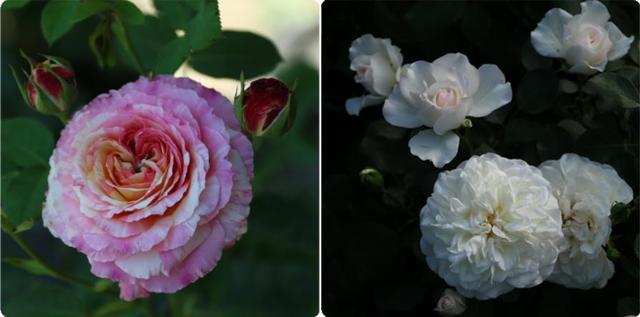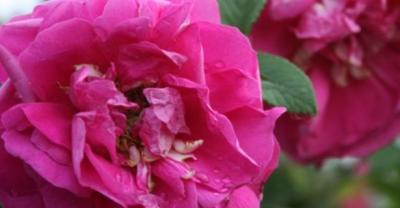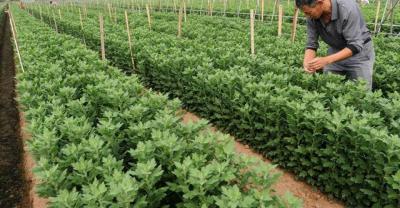Multi-season rose propagation methods, planting and field management
Breeding and field management of multi-season roses
Multi-season rose is a variety of rose that adapts to the environment and has many flowering seasons.
The propagation mode of multi-season rose
Multi-season rose is a kind of vegetative propagation, and its propagation method is mainly cuttage, that is, after defoliation in autumn, rose branches are properly harvested, cut into cuttings with 3 or 4 buds and 10~15cm in length, and treated with various disinfectants, such as stone sulfur mixture, Bordeaux solution, etc., and the cuttings are planted in the greenhouse for overwintering culture. If there is no greenhouse, the cuttings can be buried in leeward and sunny soil to effectively ensure the germination rate of cuttings. Before cutting in early spring, the cuttings should be soaked in rooting powder solution for 5 minutes for 10 minutes, and then placed on the finished sandy loam cutting bed. The row spacing of the cutter is 10cm, the distance of each cuttage is 5cm, and the insertion depth is half of that of cuttings. After that, the soil is compacted and watered once, and a small arch shed is built in the place where rose cuttings are cut for many seasons, which can play the role of heat preservation and moisturizing. In order to ensure the soil moisture in the sandy loam bed, the film should be watered every 10 days, the watering should be carried out at noon on a sunny day, the cuttings can take root and sprout after 1 month, the film can be picked up at the beginning of May, and then planting management will be carried out in accordance with the conventional way. In general, the cuttings are cut into 15~20cm cuttings with 2 or 3 bud nodes before cutting in the rainy season. The cutting method is the same as above, and there is no need to cover the film after cuttings. However, it is necessary to pay attention to shading measures during the day, and if cuttings are inserted at night, they should be carried out in the open air.

2 planting of multi-season roses
2.1 selection and arrangement of planting sites
Multi-season rose has strong adaptability, has the characteristics of sunshine, drought and cold tolerance, and has no high requirements for soil, and the sandy soil rich in organic matter is the best. In order to improve the yield and quality of multi-season rose, the planting site should have good drainage and ventilation performance, and the groundwater level should be low. Fertile neutral or slightly acidic light loam can promote the growth of multi-season rose. Rose in many seasons has strong sprouting and tillering ability and grows rapidly, but it is not resistant to stagnant water. therefore, heavy soil or low-lying waterlogged land can not be selected as planting land. After selecting the planting land, the land should be leveled, 500kg mature farm manure should be applied in each 667m2 land, and then the land should be ploughed deeply to effectively enhance the air permeability of the land.
2.2 making beds and planting
The high border cultivation method is adopted for multi-season rose. When preparing the soil, the width of the border should be set as 60~70cm, the distance of each sprouting cuttings should be 20~25cm, and the border should be covered with plastic film. Early October is the planting period of multi-season roses. the roots that have rotted or injured due to seedlings must be cut off before planting to ensure the survival rate of planting, and there is no need for over-pruning of well-developed roots, especially the main roots. When planting, the seedlings need to be stained with rooting powder to promote the growth of seedlings, and 700 multi-season roses can be planted per 667m2.

Field management of multi-season roses
3.1 Control of watering quantity
After multi-season rose seedlings are planted, the first water should be watered thoroughly, then the amount of watering should be controlled, the ground temperature should be increased, and the sprouting of new roots can be effectively promoted until the new leaves spread flat, and the watering water should be based on the principle of "dry and wet". To avoid excessive watering dampening the roots of multi-season roses. In order to prevent the early spring drought in the second year and promote the early growth and rapid hair of multi-season roses, frozen water should be poured once before freezing.
3.2 rational fertilization
Multi-season rose yield, need a lot of fertilizer, soil preparation need to apply base fertilizer, autumn defoliation to late October should be applied farm manure, and mid-tillage, fully mix soil and fertilizer. From the appearance of flower buds in the second year to the end of flower picking, mature human and animal manure or cake fertilizer should be applied three times to promote the expansion of flower buds and improve the yield and quality of multi-season roses.
3.3 proper shaping and pruning
The main results are as follows: (1) Spring: 1-year-old seedlings are fixed at the base of 5cm, leaving 3 main branches after the branches are sent out, and then 3 main branches are left in each main branch, showing the umbrella shape of 3-9 main branches. the rest of the lateral branches are properly pruned according to the density to ensure ventilation and light. For over-dense branches, dead branches, old branches or diseased branches, they must be trimmed, the cut is away from the bud 1cm, and strive to be smooth, and can be inclined from one side of the bud to the lower side of the other. (2) Autumn: it can be treated with a flat head so as not to affect the flower yield in the second year.
3.4 Control of diseases and insect pests
Multi-season rose has strong resistance to diseases and insect pests, and there are usually no diseases and insect pests, even in the period of low temperature and light, high temperature and high humidity, there are few diseases and insect pests. Powdery mildew is the main disease of multi-season roses, and its control measures are as follows: (1) pruning to remove diseased branches to reduce infection, (2) strengthening cultivation management, spraying 5 °Be stone-sulfur mixture on the planting ground and plants in spring, spraying 5 °Be stone-sulfur mixture with lower concentration again at the beginning of flower buds. (3) if it is used for greening and ornamental, all kinds of chemicals can be used to control the disease, such as carbendazim, trimethoprim, chlorothalonil and so on.
3.5 harvesting and drying
The harvest time of multi-season roses is determined according to their use. when they are ready to bloom, they are harvested for tea, for wine at the beginning, and for beverages and rose sauces when they are in full bloom. If the flowers can not be dried in time, they should be frozen at-10 ℃. The drying time and temperature depend on the use. If they are used for medicine or oil extraction, they need to be dried by high heat. If you make rose tea, you need to bake for 15-24 hours, first with 30-90 ℃ for 10 hours, and finally with 110 ℃ for color determination.

- Prev

Planting succulent plants: hydroponic cultivation (Green Field lesson 1)
Succulent plants can also be hydroponically cultured and have many advantages over soil culture, but these advantages are time-limited and the shelf life is not long, because of water.
- Next

How to improve the planting method of perilla yield
The planting method of how to improve the yield of perilla is alias red perilla, red perilla, black perilla, red perilla, wrinkled perilla and so on. Perilla is the zone of perilla of the genus Perilla of Labiatae.
Related
- Fuxing push coffee new agricultural production and marketing class: lack of small-scale processing plants
- Jujube rice field leisure farm deep ploughing Yilan for five years to create a space for organic food and play
- Nongyu Farm-A trial of organic papaya for brave women with advanced technology
- Four points for attention in the prevention and control of diseases and insect pests of edible fungi
- How to add nutrient solution to Edible Fungi
- Is there any good way to control edible fungus mites?
- Open Inoculation Technology of Edible Fungi
- Is there any clever way to use fertilizer for edible fungus in winter?
- What agents are used to kill the pathogens of edible fungi in the mushroom shed?
- Rapid drying of Edible Fungi

